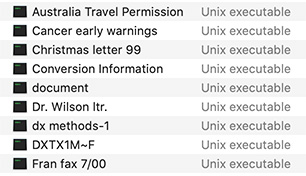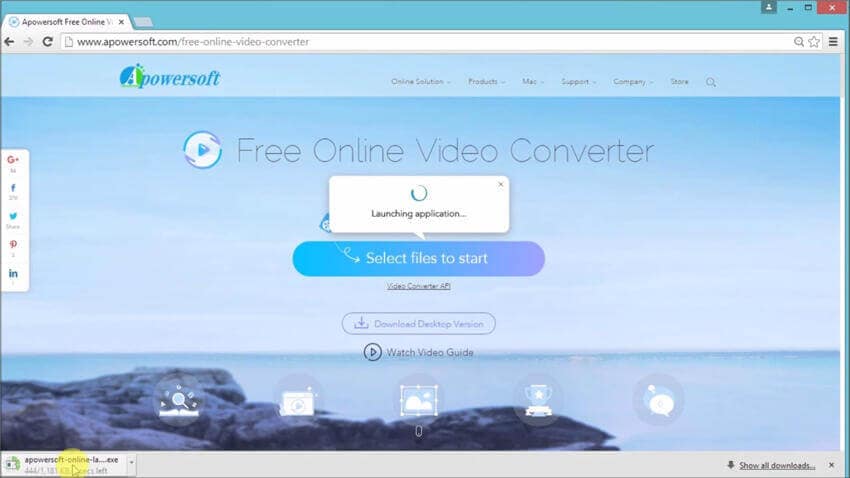I recently needed to reload some files that I archived a few years ago. When I went after them they had all been changed into Unix Executable File. This has occurred several times since I upgraded to OS X. It has happened to files of all types and they won’t open, and I can’t retrieve any data with any of the file tools I have available.
- Opening Unix Executable File Mac
- Unix Executable File Converter
- Unix Executable File Converter For Mac Free Online
- What Is Unix Executable File
In the Terminal app on your Mac, use the cd command to move into the directory that contains the file you want to make executable. For example:% cd YourScriptDirectory. Enter the chmod command. For example:% chmod 755 YourScriptName.sh. After making the shell script file executable, you can run it by entering its pathname. Free File Splitter splits large files into smaller ones, and creates a small executable file that can automatically rejoin the parts to recreate the original file. Thus, the smaller parts can be rejoined without having to use this software.
Unix, Linux and the BSDs do not assume anything about files. If it says it is a Unix Executable File it is because it contains the 'magic numbers' in the header that positively identify it as an executable file. Convert PDF file to JPG software is an ideal selection for converting PDF file into image. Application allows selecting numerous image formats like JPG, JPEG, GIF, BMP, TIF, TIFF, PNG, EMF and WMF. Application allows selecting numerous image formats like JPG, JPEG, GIF, BMP, TIF, TIFF, PNG, EMF and WMF. I have a file that should be a Unix Executable File, that for some reason shows up as a Plain Text file. I have downloaded FileType - but I don't know the creator and type codes that I need. If anyone knows these I'd be very grateful.
Unix Make File Executable
Can anyone help?

'..since I upgraded to OS X.' What operating system were you using when you archived these files? What tool did you use to create the archive? Did you create self-extracting archives with the tool?
My first guess would be that those files were saved without their file extension and OS X just assumes they are unix executables.
I suggest going into 'Finder > Preferences', Advanced and enable to show all file suffix. Then take a look if those files are missing them and add the appropriate one.
Other possible options are them being Windows executables, unknown file types respectively having no application installed that could open them.
Unix, Linux and the BSDs do not assume anything about files. If it says it is a Unix Executable File it is because it contains the 'magic numbers' in the header that positively identify it as an executable file. Microsoft's operating systems are the only ones that assume that the file's extension is a positive identifer of the file type in most cases although it does some verification based on the header contents in some cases (Windows PE files, DLLs, etc).
If a file cannot be identified by the header, it is generically considered 'data' under *nix operating systems.
Yes, that is until you install applications within OS X.
If for example you install The Unarchiver and select all archive types any EXE file will be identified as 'Windows Self-Extracting Archive'.
And equally weird things happen for any file extension OS X cannot identify. My Keypass DB (.kdbx) is also identified as Unix Executable File since I don't have Keypass installed on my Mac.
An Outlook.pst file? The very same, Unix Executable File - that is regardless of me having Outlook 2011 installed which can actually import PST files..
Please don't assume OS X acts like any other UNIX system out there, because it doesn't ~ even if Apple wants it to.
Very often, in OS X, when one has a terminal command that needs to be used often, it's convenient to turn that UNIX command into a double-clickable desktop file with a recognizable icon. How can that possibly be done? I'll show you how.
Exe File Converter For Mac
OS X is based on BSD UNIX
Here's the basic outline of this tip.
- Create a UNIX script with a text editor that contains one or more terminal commands.
- Make it executable.
- Double click it in the Finder.
What Is Unix Executable File
It's really quite simple, but there are a few things to be aware of. I'll walk you through it and add some notes as needed.
I. Create a script. UNIX scripts are similar to AppleScript. There are commands and a syntax. From time to time you'll see articles that show how to change an OS X preference from the command line. For example, you may have seen this terminal command that strips the drop shadow from your screenshots:
Note #1. The Terminal app location is /Applications/Utilities/Terminal.app
Scripts are a sequence of commands, managed by the scripting language, to a achieve a task. The easiest way to write a script is to use a text editor, like OS X's built-in TextEdit, found in the Applications folder.
Note #2. Make sure the Preferences for TextEdit are set correctly. Preferences > New Document > Plain text. Once set, relaunch TextEdit.
Here's a simple script that uses the 'uptime' command to display how long it's been since your Mac was rebooted.
Note #3. The first line tells OS X to use the Bash scripting language. There are several to chose from. We won't dig into that here.
Copy and paste this script into a new TextEdit file. Call it 'ByYourCommand.txt' Save this file on your desktop.

II. Make the Script Executable.
Opening Unix Executable File Mac
1. In the Finder, delete the file extension '.txt' The Finder will ask for confirmation.
2. Open the Terminal app and navigate to the file. Substitute your own login name instead of mine. Like this:
Unix Executable File Converter
3. Still in the terminal, execute this UNIX command:
Note #4. This UNIX command makes the file executable, that is, double-clickable.
Note #5. If you have antivirus software installed, it may object, depending on its preferences, to an executable script being inserted into a file that was created by an OS X text editor. Just ignore the warning.
At this point, you'll notice that the file's icon has changed to this:
III. Double click the file 'ByYourCommand' on the desktop. The Terminal app will launch, the script will be executed, and you'll see the results, like this:
Uptime: one day, 21 h since my last reboot.
Unix Executable File Converter For Mac Free Online
If you need to edit the script, you'll have to add the '.txt' extension back. (Or, as the geeks will point out, edit with a UNIX editor like vi. I had to say that.)
What Is Unix Executable File
This is as far as we'll go with a one line command. Once you get the hang of this and learn a whole lot more, you'll find yourself happily creating your own custom scripts—if you decide to learn Bash or one of the other UNIX shells available. A new door is open to create your own scripts, but you should, of course, learn much more about UNIX and scripting before you go wild with this newfound superpower. A really careless act could render your OS X corrupted and/or unbootable.